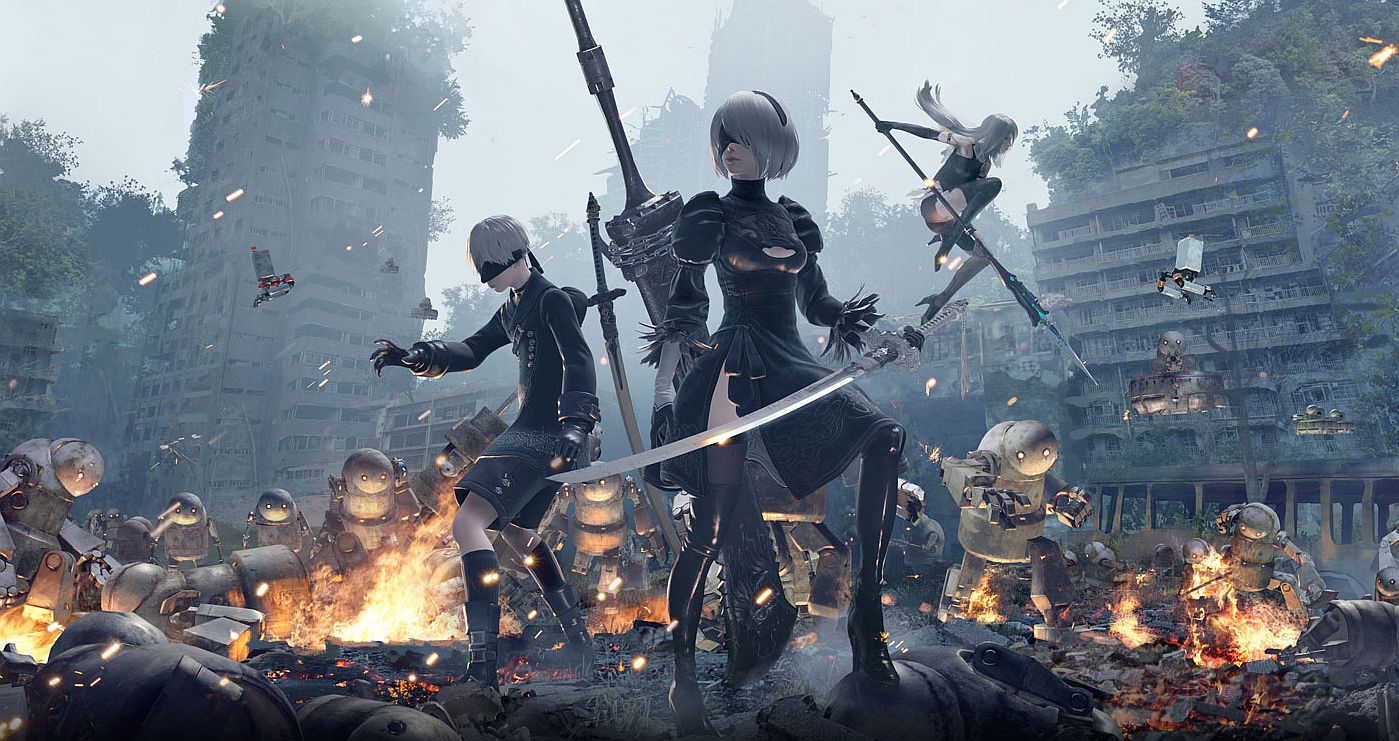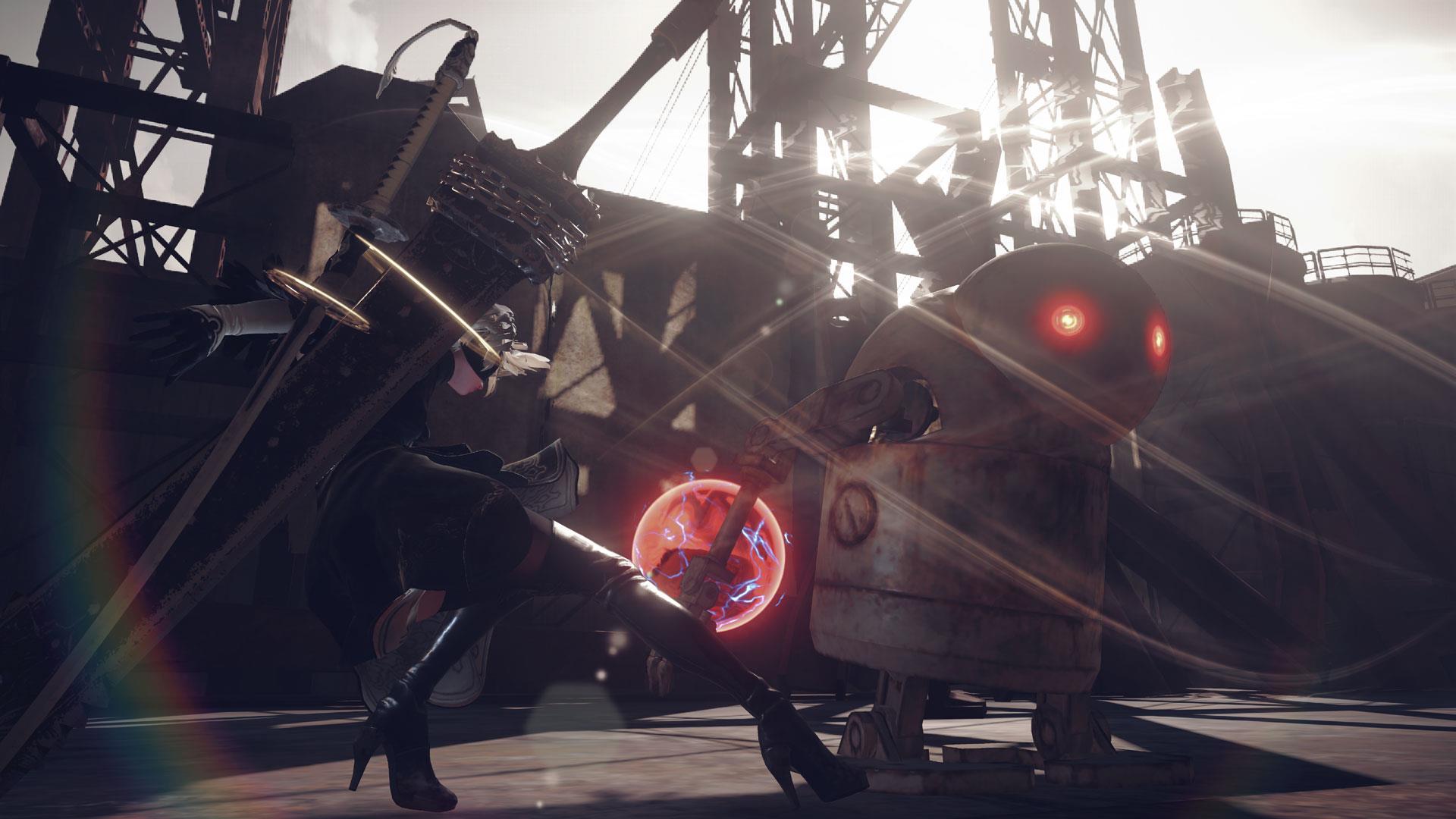
Taro Yoko is a bit of a game design hero of mine. He’s a game design punk; he makes what he wants, and the end result is often weird and wonderful all at once. He’s best known for his work on weird, outlandish JRPG titles Drakengard and Nier, bizarre games that beneath their quirk usually have something real to say too.
“Don’t worry. That really crass, really odd, weird shit you expect from Nier is still in there. We’re quite confident in creating content like that!”
He’s made a reputation of his unique style. In public appearances, he dons a mask. When I sit down to interview him alongside Nier Automata producer Yosuke Saito and game designer Takahisa Taura, he seems all too gleefully happy to lean into that reputation.
“I do want to reassure everyone,” he chuckles when I ask if Automata will live up to his trademark style, “Don’t worry. That really crass, really odd, weird shit you expect from Nier is still in there. We’re quite confident in creating content like that!”
As I touched on in my previous hands-on it’s something of a shocker that Automata exists at all. The original Nier was the very definition of a low-selling cult hit, but Automata appears to be finding a new audience, especially in the wake of an impressive downloadable demo. Yoko puts this down to the addition of action aficionados Platinum Games as a development partner.
“We’ve got this real feeling coming out of Japan and seeing the markets overseas,” Yoko says. “Platinum Games has this great brand recognition; a great reputation abroad. It’s really thanks to us partnering with them and them being involved with the project that we’ve got this recognition for Nier now, I think.”

Putting Automata’s sudden surge in interest down to Platinum fits in with a theme about Yoko; he’s self-deprecating. Nier’s weirdness comes due to him not having the mainstream pressures of other games rather than him having a stand-out vision, he says. “I thought – well, it’s Nier, it’s not going to sell very well whatever,” he laughs when asked about a specific decision.
The original Nier was in a sense the best six out of ten I’ve ever given. The game was rough around the edges in a way that displayed its limited budget, but it was bursting with mad, subversive ideas and an ambition at the time not on display in even Square’s big-budget efforts. The exciting thing about Nier Automata is that it pairs Yoko’s crazy vision with Platinum, a development house skilled at delivering tightly-wound experiences.
Or, as Automata producer Yosuke Saito puts it: “I had a feeling that when I managed to finalise the contract for the partnership 99 percent of my work was out of the way!”
“I personally don’t think it’s just down to Platinum Games,” Platinum employee Takahisa Taura offers. “I think what people are interested in is this sort of almost impossible to expect collaboration between Square Enix and Platinum, or Yoko Taro and Platinum. That really weird and quite great potential from that collaboration is what people are watching.”
Before I go in for the interview I have some time to play an extended build of Nier Automata. It opens up with a bad ass segment that leads into the demo content and features… well, there’s a lot of stuff I can’t talk about. It’s a long bullet-point list and it’s easier to just say: look, it’s pretty good. Combat feels good. Its narrative intrigues, and though I have concerns about how repetitive certain content will be I’m pumped to play the final thing.

In areas we can talk about, Automata seems an interesting mix of Platinum-brand action, Square brand RPG and Yoko-brand madness. At one point I end up in a wide open area, a city partially reclaimed by nature in the post-apocalypse. Here I have a surprising amount of freedom for an action-based game: I can take on side quests, I can buy items to tame a deer and ride it, I can dabble in combat or I can seamlessly walk into a town where beautiful and relaxing music swells as an indicator of your seamless transition into a safe zone free of potentially violent wildlife or definitely violent robots.
“That’s something I really want people to experience – Platinum aren’t just about the action, but their RPG stuff is really good, too.”
When you die, you mysteriously leave behind a corpse like a Dark Souls bloodstain. When you reach it you can either retrieve some lost stuff from your fallen body or revive it to fight alongside you as an NPC. You can even leave bloodstain-style messages that curiously take on a haiku-style 5-7-5 syllable format alongside corpses, though Square, who aren’t yet talking about online features, wouldn’t explain what for.
If you want you can take time out to go fishing, where in a cute touch your little robot pod buddy is also your tackle. If you buy the right stuff from a store, you can tame the local deer and ride them, or you can just kill them for resources. Basically: it’s a proper RPG as well as a Platinum game.
“The guys at Platinum, they really love RPGs as well, Taro notes. “They came up with loads of great ideas and elements for out-there character development growth systems and all kinds of really cool aspects for the game. They put a lot of effort into that. That’s something I really want people to experience – Platinum aren’t just about the action, but their RPG stuff is really good, too.”

Enter Takahisa Taura, game designer on Automata from the Platinum side. With the likes of Madworld and Metal Gear Rising on his resume, he clearly has the chops. Taro teases him throughout the interview by repeatedly telling me he’ll be the next Hideo Kojima, which Taura vehemently and humbly rejects, embarrassed. “Taura Productions!” Yoko gleefully yells out after the younger developer finishes an interview answer.
“I think people will obviously expect the action from us and expect that everything will be completely action focused, but there are a lot of really cool other RPG elements in there too,” Taura says, following on from Yoko.
“There’s stuff like collecting money to upgrade your weapons, collecting materials, the ability to customise your characters… those proper, classic RPG elements you expect. People may think that’s not very us, that it doesn’t reflect on what Platinum Games is known for, but we think that people will have a lot of fun with those elements, so I really hope people pay attention to those as well.”
“Platinum Games has this great brand recognition; a great reputation abroad. It’s really thanks to us partnering with them and them being involved with the project that we’ve got this recognition for Nier now, I think.”
One of the interesting facts about Automata’s development partnership with Platinum is that the game is largely coming from a new, younger team within the studio. It’s a team perhaps less shackled by past experiences, and as a result they’ve been able to lean into the ‘crass, weird shit’ Taro is known for and boasted of earlier – all while retaining the tight feel of a Platinum action game.
The ‘OS Chip’ item that fans found in the demo that when unequipped causes your character to instantly die without warning (how can an android survive without an operating system?) was, for instance, a Platinum pull that Yoko merely approved of.
Through this and other comments it’s clear that Platinum has fully embraced what made Taro’s vision of the original Nier so special, but they’re combining it with much more exciting gameplay mechanics. The hands-on drives this home too, with even a two hour slice bursting with ideas clearly inspired by a wide variety of Nier’s peers.
Broad as it may be, Nier still proudly clings to its niche credentials. “The good thing about [more niche] games is that you kind of go deep,” says Saito. “You go deep and have a good core, loyal following rather than trying to spread out too widely.”
The Nier series is unlikely to set the world ablaze and I remain curious in how its mechanics will hold up over 20-plus hours, but already Nier Automata looks like a cult classic in the making. That’s hard to complain about. Indeed, that focus on its niche might even be its greatest strength.
Nier Automata is out in Japan on February 23, while the game will be available in Europe and North America on March 7 for PS4. A PC version is coming, but that doesn’t yet have a release date.
Comments
Post a Comment